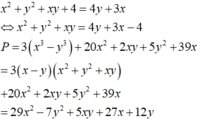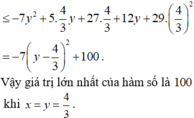Cho các số thực a,b thỏa mãn: 4x2+2xy+y2=3. Tìm GTNN, GTLN của P=x2+2xy-y2

Những câu hỏi liên quan
1. Cho x,y thỏa mãn: x2 + 5y2 - 4xy + 2y = 3. Tìm x,y sao cho x đạt GTLN
2. Cho x,y thỏa mãn: 3x2 + y2 + 2xy + 4 = 7x + 3y
a) Tìm GTNN, GTLN của biểu thức P = x + y
b) Tìm GTNN, GTLN của x
3. Cho x,y thỏa mãn: x2 + 2y2 + 2xy + 7x + 7y + 10 = 0. Tìm GTLN, GTNN của S = x + y
cho 2 số dương x;y thỏa mãn x2 + y2 = 1, tìm GTLN của biểu thức :
\(P=\dfrac{2xy+1}{x+y+1}\)
Ta có \(x^2+y^2=1\Leftrightarrow\left(x+y\right)^2=2xy+1\)
Từ đó \(P=\dfrac{\left(x+y\right)^2}{x+y+1}\). Đặt \(x+y=t\left(t\ge0\right)\). Vì \(x+y\le\sqrt{2\left(x^2+y^2\right)}=2\) nên \(t\le\sqrt{2}\). ĐTXR \(\Leftrightarrow x=y=\dfrac{1}{\sqrt{2}}\). Ta cần tìm GTLN của \(P\left(t\right)=\dfrac{t^2}{t+1}\) với \(0\le t\le\sqrt{2}\).
Giả sử có \(0\le t_1\le t_2\le\sqrt{2}\). Ta có BDT luôn đúng \(\left(t_2-t_1\right)\left(t_2+t_1+t_2t_1\right)\ge0\) \(\Leftrightarrow t_2^2-t_1^2+t_2^2t_1-t_2t_1^2\ge0\) \(\Leftrightarrow t_1^2\left(t_2+1\right)\le t_2^2\left(t_1+1\right)\) \(\Leftrightarrow\dfrac{t_1^2}{t_1+1}\le\dfrac{t_2^2}{t_2+1}\) \(\Leftrightarrow P\left(t_1\right)\le P\left(t_2\right)\). Như vậy với \(0\le t_1\le t_2\le\sqrt{2}\) thì \(P\left(t_1\right)\le P\left(t_2\right)\). Do đó P là hàm đồng biến. Vậy GTLN của P đạt được khi \(t=\sqrt{2}\) hay \(x=y=\dfrac{1}{\sqrt{2}}\), khi đó \(P=2\sqrt{2}-2\)
Đúng 3
Bình luận (0)
Lời giải:
$P=\frac{2xy+1}{x+y+1}=\frac{2xy+x^2+y^2}{x+y+1}=\frac{(x+y)^2}{x+y+1}$
$=\frac{a^2}{a+1}$ với $x+y=a$
Áp dụng BĐT AM-GM:
$1=x^2+y^2\geq \frac{(x+y)^2}{2}=\frac{a^2}{2}$
$\Rightarrow a^2\leq 2\Rightarrow a\leq \sqrt{2}$
$P=\frac{a^2}{a+1}=\frac{a}{1+\frac{1}{a}}$
Vì $a\leq \sqrt{2}\Rightarrow 1+\frac{1}{a}\geq 1+\frac{1}{\sqrt{2}}=\frac{2+\sqrt{2}}{2}$
$\Rightarrow P\leq \frac{\sqrt{2}}{\frac{2+\sqrt{2}}{2}}=-2+2\sqrt{2}$
Vậy $P_{\max}=-2+2\sqrt{2}$ khi $x=y=\frac{1}{\sqrt{2}}$
Đúng 1
Bình luận (0)
Tìm GTLN hoặc GTNN của các đa thưc sau:
Xem chi tiết
a, -x2 + 2x + 3
b, x2 - 2x + 4y2 - 4y + 8 c, -x2 - y2 + xy + 2x + 2y + 4 d, x2 + 5y2 - 4xy - 2y + 2015 e, 2x2 + y2 + 6x + 2y + 2xy + 2018A= -x2+2x+3
=>A= -(x2-2x+3)
=>A= -(x2-2.x.1+1+3-1)
=>A=-[(x-1)2+2]
=>A= -(x+1)2-2
Vì -(x+1)2 ≤0=> A≤-2
Dấu "=" xảy ra khi
-(x+1)2=0 => x=-1
Vây A lớn nhất= -2 khi x= -1
Đúng 4
Bình luận (0)
B=x2-2x+4y2-4y+8
=> B= (x2-2x+1)+(4y2-4y+1)+6
=> B=(x-1)2+(2y+1)2+6
=> B lớn nhất=6 khi x=1 và y=-1/2
Đúng 2
Bình luận (0)
Tính GTNN, GTLN của các biểu thức sau:
a)A(x,y)=4x2+y2+4x-y+1
b)B(x,y)=2x2+y2+2xy-x+5
Toán lớp 8Lớn nhất - nhỏ nhất
Xem chi tiết
Cho x,y là các số thực thỏa mãn: x2+y2+xy ≤ 1
Tìm max P = x2+2xy
Rút gọn các biểu thức sau:
a) (x + 3)(x2 – 3x + 9) – (54 + x3)
b) (2x + y)(4x2 – 2xy + y2) – (2x – y)(4x2 + 2xy + y2)
a) (x + 3)(x2 – 3x + 9) – (54 + x3)
= ( x + 3)(x2 – 3.x + 32) – (54 + x3)
= x3 + 33 – (54 + x3)
= x3 + 27 – 54 – x3
= -27
b) (2x + y)(4x2 – 2xy + y2) – (2x – y)(4x2 + 2xy + y2)
= (2x + y)[(2x)2 – 2x.y + y2] – (2x – y)[(2x)2 + 2x.y + y2]
= [(2x)3 + y3] – [(2x)3 – y3]
= (2x)3 + y3 – (2x)3 + y3
= 2y3
Đúng 0
Bình luận (0)
a) (x + 3)(x2 – 3x + 9) – (54 + x3)
= ( x + 3)(x2 – 3.x + 32) – (54 + x3)
= x3 + 33 – (54 + x3) = x3 + 27 – 54 – x3
= -27
b) (2x + y)(4x2 – 2xy + y2) – (2x – y)(4x2 + 2xy + y2)
= (2x + y)[(2x)2 – 2x.y + y2] – (2x – y)[(2x)2 + 2x.y + y2]
= [(2x)3 + y3] – [(2x)3 – y3]
= (2x)3 + y3 – (2x)3 + y3
= 2y3
Đúng 0
Bình luận (0)
Cho x,y là các số thực thoả mãn điều kiện 3x2 y2 10x 6y 2xy 14. Tìm GTLN của x y
Cho số thực x, y thỏa mãn
x
2
+
y
2
+
x
y
4
y
−
1
+
3
x
. Tìm giá trị lớn nhất của biểu thức
P
3
x
3
−
y
3...
Đọc tiếp
Cho số thực x, y thỏa mãn x 2 + y 2 + x y = 4 y − 1 + 3 x . Tìm giá trị lớn nhất của biểu thức P = 3 x 3 − y 3 + 20 x 2 + 2 x y + 5 y 2 + 39 x
A. 120 2
B. 110
C. 100
D. 96 3
Đáp án C
G T ⇔ x 2 + y − 3 x + y 2 − 4 y + 4 = 0 y 2 + x − 4 y + x 2 − 3 x + 4 = 0
có nghiệm ⇔ Δ x ≥ 0 Δ y ≥ 0 ⇔ 0 ≤ x ≤ 4 3 1 ≤ y ≤ 7 3
Và:
x y = 3 x + 4 y − x 2 − y 2 − 4 ⇒ P = 3 x 3 + 18 x 2 + 45 x − 8 ⏟ f x + − 3 y 3 + 3 y 2 + 8 y ⏟ g y
Xét hàm số f x = 3 x 3 + 18 x 2 + 45 x − 8 trên 0 ; 4 3 ⇒ max 0 ; 4 3 f x = f 4 3 = 820 9
Xét hàm số g x = − 3 y 3 + 3 y 2 + 8 y trên 1 ; 7 3 ⇒ max 1 ; 7 3 g x = f 4 3 = 80 9
Vật P ≤ max 0 ; 4 3 f x + max 1 ; 7 3 g x = 100
Dấu “=” xảy ra khi x = y = 4 3
Đúng 0
Bình luận (0)
Cho x,y là hai số thực thỏa mãn điều kiện
x
2
+
y
2
+
x
y
+
4
4
y
+
3
x
. Tìm giá trị lớn nhất của biểu thức
P
3
(
x...
Đọc tiếp
Cho x,y là hai số thực thỏa mãn điều kiện x 2 + y 2 + x y + 4 = 4 y + 3 x . Tìm giá trị lớn nhất của biểu thức P = 3 ( x 3 - y 3 ) + 20 x 2 + 2 x y + 5 y 2 + 39 x .
![]()


![]()




















